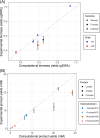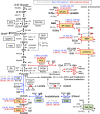Genome-Scale Metabolic Model of Caldicellulosiruptor bescii Reveals Optimal Metabolic Engineering Strategies for Bio-based Chemical Production
- PMID: 34060912
- PMCID: PMC8269263
- DOI: 10.1128/mSystems.01351-20
Genome-Scale Metabolic Model of Caldicellulosiruptor bescii Reveals Optimal Metabolic Engineering Strategies for Bio-based Chemical Production
Abstract
Metabolic modeling was used to examine potential bottlenecks that could be encountered for metabolic engineering of the cellulolytic extreme thermophile Caldicellulosiruptor bescii to produce bio-based chemicals from plant biomass. The model utilizes subsystems-based genome annotation, targeted reconstruction of carbohydrate utilization pathways, and biochemical and physiological experimental validations. Specifically, carbohydrate transport and utilization pathways involving 160 genes and their corresponding functions were incorporated, representing the utilization of C5/C6 monosaccharides, disaccharides, and polysaccharides such as cellulose and xylan. To illustrate its utility, the model predicted that optimal production from biomass-based sugars of the model product, ethanol, was driven by ATP production, redox balancing, and proton translocation, mediated through the interplay of an ATP synthase, a membrane-bound hydrogenase, a bifurcating hydrogenase, and a bifurcating NAD- and NADP-dependent oxidoreductase. These mechanistic insights guided the design and optimization of new engineering strategies for product optimization, which were subsequently tested in the C. bescii model, showing a nearly 2-fold increase in ethanol yields. The C. bescii model provides a useful platform for investigating the potential redox controls that mediate the carbon and energy flows in metabolism and sets the stage for future design of engineering strategies aiming at optimizing the production of ethanol and other bio-based chemicals. IMPORTANCE The extremely thermophilic cellulolytic bacterium, Caldicellulosiruptor bescii, degrades plant biomass at high temperatures without any pretreatments and can serve as a strategic platform for industrial applications. The metabolic engineering of C. bescii, however, faces potential bottlenecks in bio-based chemical productions. By simulating the optimal ethanol production, a complex interplay between redox balancing and the carbon and energy flow was revealed using a C. bescii genome-scale metabolic model. New engineering strategies were designed based on an improved mechanistic understanding of the C. bescii metabolism, and the new designs were modeled under different genetic backgrounds to identify optimal strategies. The C. bescii model provided useful insights into the metabolic controls of this organism thereby opening up prospects for optimizing production of a wide range of bio-based chemicals.
Keywords: Caldicellulosiruptor; bio-based chemical production; central carbon metabolism; metabolic engineering; metabolic modeling; redox balance.
Figures




Similar articles
-
Transcriptional Regulation of Plant Biomass Degradation and Carbohydrate Utilization Genes in the Extreme Thermophile Caldicellulosiruptor bescii.mSystems. 2021 Jun 29;6(3):e0134520. doi: 10.1128/mSystems.01345-20. Epub 2021 Jun 1. mSystems. 2021. PMID: 34060910 Free PMC article.
-
Metabolic engineering of Caldicellulosiruptor bescii for 2,3-butanediol production from unpretreated lignocellulosic biomass and metabolic strategies for improving yields and titers.Appl Environ Microbiol. 2024 Jan 24;90(1):e0195123. doi: 10.1128/aem.01951-23. Epub 2023 Dec 22. Appl Environ Microbiol. 2024. PMID: 38131671 Free PMC article.
-
Xylanolytic metabolism is regulated by coordination of transcription factors XynR and XylR in extremely thermophilic Caldicellulosiruptorales.Appl Environ Microbiol. 2025 Jul 23;91(7):e0051625. doi: 10.1128/aem.00516-25. Epub 2025 Jun 4. Appl Environ Microbiol. 2025. PMID: 40464575 Free PMC article.
-
Management of urinary stones by experts in stone disease (ESD 2025).Arch Ital Urol Androl. 2025 Jun 30;97(2):14085. doi: 10.4081/aiua.2025.14085. Epub 2025 Jun 30. Arch Ital Urol Androl. 2025. PMID: 40583613 Review.
-
Signs and symptoms to determine if a patient presenting in primary care or hospital outpatient settings has COVID-19.Cochrane Database Syst Rev. 2022 May 20;5(5):CD013665. doi: 10.1002/14651858.CD013665.pub3. Cochrane Database Syst Rev. 2022. PMID: 35593186 Free PMC article.
Cited by
-
Transcriptional Regulation of Plant Biomass Degradation and Carbohydrate Utilization Genes in the Extreme Thermophile Caldicellulosiruptor bescii.mSystems. 2021 Jun 29;6(3):e0134520. doi: 10.1128/mSystems.01345-20. Epub 2021 Jun 1. mSystems. 2021. PMID: 34060910 Free PMC article.
-
Engineering Caldicellulosiruptor bescii with Surface Layer Homology Domain-Linked Glycoside Hydrolases Improves Plant Biomass Solubilization.Appl Environ Microbiol. 2022 Oct 26;88(20):e0127422. doi: 10.1128/aem.01274-22. Epub 2022 Sep 28. Appl Environ Microbiol. 2022. PMID: 36169328 Free PMC article.
-
Metabolic engineering of Caldicellulosiruptor bescii for 2,3-butanediol production from unpretreated lignocellulosic biomass and metabolic strategies for improving yields and titers.Appl Environ Microbiol. 2024 Jan 24;90(1):e0195123. doi: 10.1128/aem.01951-23. Epub 2023 Dec 22. Appl Environ Microbiol. 2024. PMID: 38131671 Free PMC article.
-
Biochemical and Regulatory Analyses of Xylanolytic Regulons in Caldicellulosiruptor bescii Reveal Genus-Wide Features of Hemicellulose Utilization.Appl Environ Microbiol. 2022 Nov 8;88(21):e0130222. doi: 10.1128/aem.01302-22. Epub 2022 Oct 11. Appl Environ Microbiol. 2022. PMID: 36218355 Free PMC article.
-
Biofuel production from lignocellulose via thermophile-based consolidated bioprocessing.Eng Microbiol. 2024 Sep 10;4(4):100174. doi: 10.1016/j.engmic.2024.100174. eCollection 2024 Dec. Eng Microbiol. 2024. PMID: 39628591 Free PMC article. Review.
References
-
- Yang S-J, Kataeva I, Hamilton-Brehm SD, Engle NL, Tschaplinski TJ, Doeppke C, Davis M, Westpheling J, Adams MWW. 2009. Efficient degradation of lignocellulosic plant biomass, without pretreatment, by the thermophilic anaerobe “Anaerocellum thermophilum” DSM 6725. Appl Environ Microbiol 75:4762–4769. doi:10.1128/AEM.00236-09. - DOI - PMC - PubMed
LinkOut - more resources
Full Text Sources
Molecular Biology Databases
Miscellaneous
